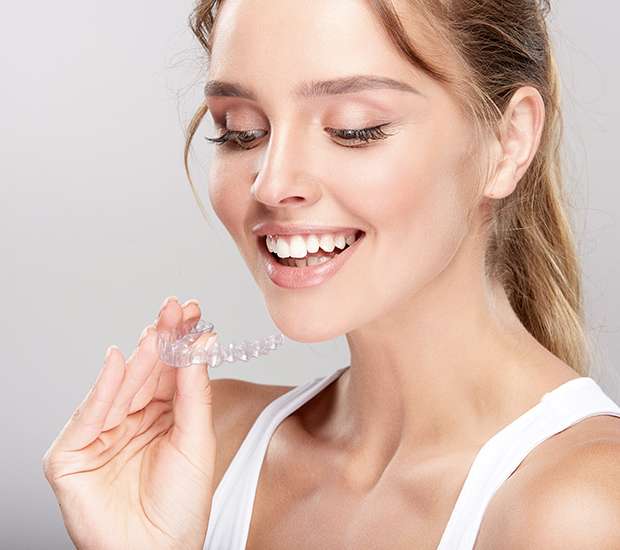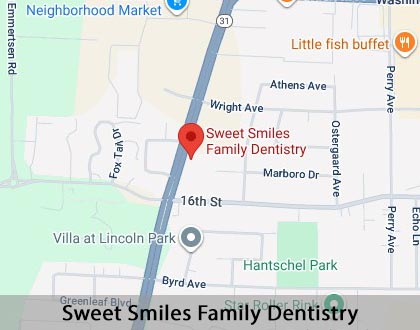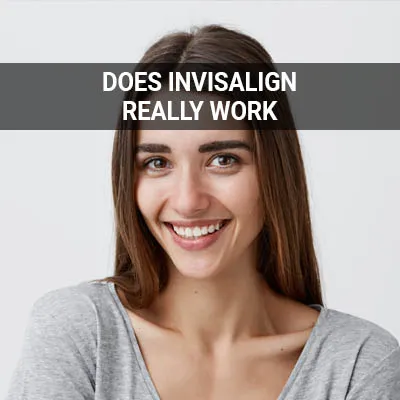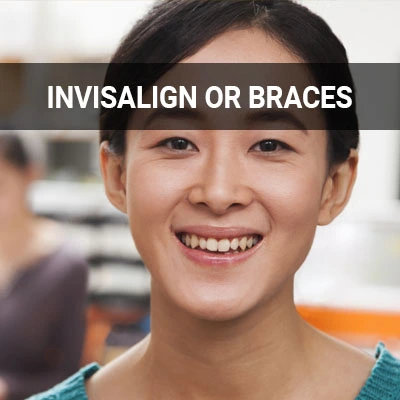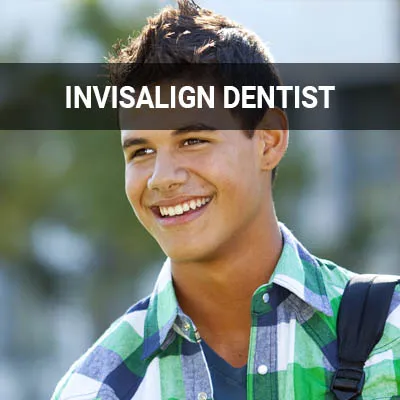Invisalign Mt Pleasant, WI
Clear orthodontic aligners have been growing in popularity for many years. One of the most recognizable brands is Invisalign®. Invisalign is a form of orthodontics that uses clear tray aligners to straighten the teeth instead of the traditional mouthful of metal wires and brackets.
If you are a candidate, Invisalign provides an almost invisible way to straighten your teeth. Invisalign is available at Sweet Smiles Mt Pleasant in Mt Pleasant and the surrounding area. Call us at (262) 276-4601 to schedule an appointment to see if this treatment is right for you.
History of Invisalign
Invisalign is a nearly invisible orthodontic alternative to traditional metal braces. This treatment uses clear plastic trays that apply gentle, consistent pressure to specific parts of teeth to move them into alignment slowly. It is a great option for people who do not want visible metal brackets and wires in their mouths.
Zia Chishti got the idea for Invisalign after realizing that a series of retainers could move teeth just as effectively as metal braces. Chishti and his team created a program to model a patient's current bite and design the series of trays that they would need to achieve a straight smile. Invisalign has made it possible for people who would never choose metal braces, for cosmetic or health reasons, to get the smile they have always wanted.
“Invisalign is a nearly invisible orthodontic alternative to traditional metal braces.”
Invisalign’s Three Steps
The first step to getting Invisalign is by scheduling a consultation with our dentist. Our staff will look at overall oral health and take impressions of the mouth. Next, that impression is sent to Invisalign and used to make aligners unique to the patient's mouth for a custom fit.
Once the aligners have been made, our staff will make sure they fit well, answer any questions, and go over the treatment plan. Patients will be expected to wear the aligners for 20 to 22 hours a day to get results. Regular checkups with Sweet Smiles Mt Pleasant will make sure treatment stays on track. Our staff will determine how often new aligners are needed.
After the desired results have been achieved, the patient may be expected to wear a retainer to maintain those results. This will prevent teeth from gradually shifting back to their initial position. Our doctor will provide specific instructions on how often a retainer will need to be worn.
“The first step to getting Invisalign is by scheduling a consultation with our dentist.”
The Pros and Cons of Invisalign
Invisalign is not without its pros and cons. Thanks to the fact that they are next-to-invisible, both teens and adults can avoid the discomfort and self-consciousness of traditional metal braces. Many patients also appreciate that they can take Invisalign aligners out to eat, brush and floss, or for social situations.
However, since they are removable, they are more likely to be lost or broken. Patients also need to be careful about what they drink when their aligners are in. Anything but water should be avoided. Liquids can seep into the plastic and stay there until the aligner is removed. This can lead to staining of the aligner and even tooth decay.
“Thanks to the fact that they are next-to-invisible, both teens and adults can avoid the discomfort and self-consciousness that comes with traditional metal braces.”
Check out what others are saying about our dental services on Yelp: Invisalign in Mt Pleasant, WI
Taking Care of Invisalign Aligners
It is essential to use and care for Invisalign aligners appropriately to have a good orthodontic outcome. For Invisalign to work, the aligners have to be worn for the recommended number of hours a day. Patients should try to limit the number of times they remove the aligners since it will not take long to exceed the time they can be left off.
Cleaning the Aligners
Patients should always rinse the aligners when they are removed. Bacteria and plaque can easily attach to them, which can cause an unpleasant odor and sticky feeling on the teeth. Aligners should be cleaned with a clear and unscented antibacterial soap. If patients use toothpaste to clean the aligners, they should make sure that it is not a brand with whitening agents, as these can wear away the plastic.
Invisalign aligners need to be stored in a case when not being worn. Leaving them out in the open exposes them to germs that can then be transferred to the mouth.
Maintain Proper Oral Hygiene
Proper oral hygiene is essential at any time, but it is a bit easier when using Invisalign versus traditional braces. Food and plaque can get trapped in conventional braces' metal brackets and can be tough to brush. Since Invisalign aligners can be removed, it is simple to brush and floss and replace the aligners when finished.
Make sure to brush and floss after meals before putting the aligners back in the mouth. This helps keep food particles from getting stuck in the aligners, leading to bacteria growth and bad breath.
“It is essential to use and care for Invisalign aligners appropriately to have a good orthodontic outcome.”
Questions Answered on This Page
Q. What steps are involved with getting Invisalign?
Q. What are the pros and cons of Invisalign?
Q. How do I use and care for Invisalign aligners?
Q. What is the duration of Invisalign treatment?
People Also Ask
Q. What are the differences between Invisalign and traditional braces?
Q. What age groups use Invisalign?
Q. How often do I need to wear my clear aligners?
Q. Are braces or Invisalign aligners more effective?
Q. What are some examples of purely cosmetic procedures?
Q. How should you choose the right treatment and cosmetic dentist?
Treatment Length
The treatment length will depend on various factors, such as the case complexity and how often the patient wears their aligners. Our team will determine how long each patient's treatment will take based on their specific needs and goals. We will provide patients with a more precise duration estimate during their consultation.
The average length of Invisalign treatment is 12 to 18 months. However, people will be able to start seeing changes within a matter of weeks. An article in Progress in Orthodontics concluded that Invisalign might treat mild non-extraction cases more quickly but that more complicated cases require more time than fixed appliance treatment.
“The average length of Invisalign treatment is 12 to 18 months.”
Frequently Asked Questions
Q. Does Invisalign hurt?
A. Invisalign treatment is not painful, but it can cause teeth to feel sore. When patients switch out their trays, it is normal to experience some discomfort due to the pressure exerted on teeth. This is a sign that the treatment is progressing and teeth are moving into alignment.
Q. How often will I return for appointments during Invisalign treatment?
A. Invisalign treatment can save patients time coming to the office. While other orthodontic treatments typically require patients to return for adjustment appointments about every three or four weeks, Invisalign patients do not need checkups as often. Patients will need to visit our office about once every four to six weeks to ensure that the treatment progresses as planned.
Q. What are Invisalign attachments?
A. Invisalign attachments are small button-like attachments that are temporarily attached to teeth. We place these attachments at specific locations to help the aligners grip teeth as they are moving them into alignment. Not every patient will need Invisalign attachments. Our team will determine whether they are necessary.
Q. Is it normal for my teeth to feel loose after removing my Invisalign aligners?
A. It is normal for patients to feel like their teeth are loose after removing aligners. This is because their teeth are shifting. As aligners gradually move teeth into their proper position, the gums are also re-forming around each tooth.
Q. Will wearing Invisalign aligners affect my speech?
A. Any orthodontic appliance has the potential to affect a person's speech. Invisalign is not likely to cause any speech problems. Patients may notice a slight lisp when speaking, but it should disappear as the tongue gets used to the aligners.
Invisalign® Terminology
Learn More About Invisalign
For many patients, Invisalign is a practical alternative to traditional braces. If you are interested in finding out whether this treatment is right for you, call Sweet Smiles Mt Pleasant in Mt Pleasant at 262-276-4601 to learn more about whether or not you are a candidate.
Helpful Related Links
- American Dental Association (ADA). Glossary of Dental Clinical Terms. 2025
- American Academy of Cosmetic Dentistry® (AACD). Home Page. 2025
- Invisalign®. How Invisalign Works. 2025
- Invisalign®. Take the Smile Assessment. 2025
- WebMD. WebMD’s Oral Care Guide. 2025
About our business, license, and website security
- Sweet Smiles Mt Pleasant was established in 2018.
- We accept the following payment methods: American Express, Cash, Discover, MasterCard, and Visa
- We serve patients from the following counties: Racine County
- We serve patients from the following cities: Mt Pleasant, Sturtevant, Elmwood Park, Racine, and Yorkville
- WI (License #6964-15). View License Information and Specifics
- National Provider Identifier Database (1396090734). View NPI Registry Information
- Norton Safe Web. View Details
- Trend Micro Site Safety Center. View Details
Back to top of Invisalign
